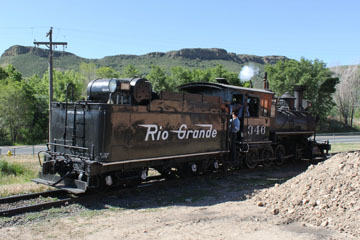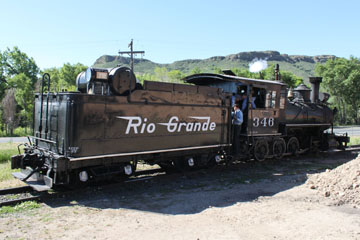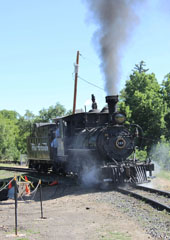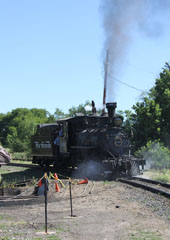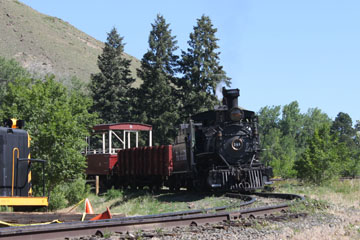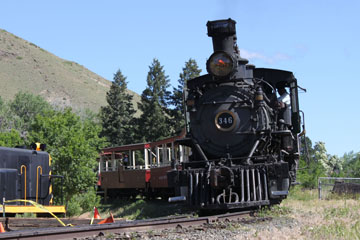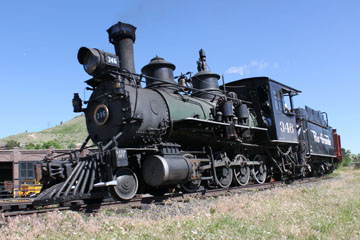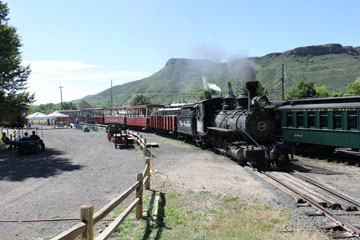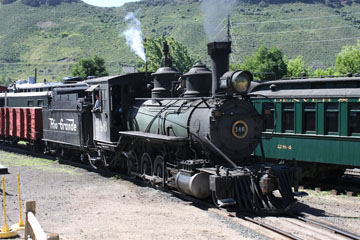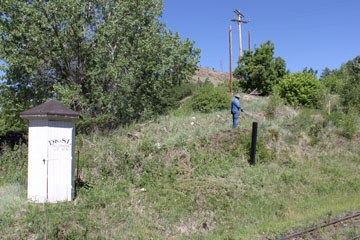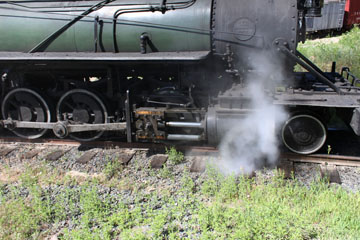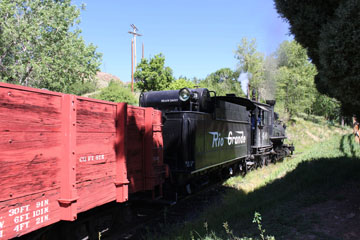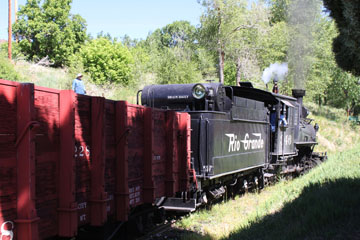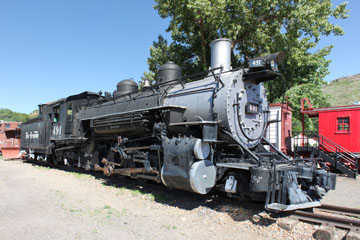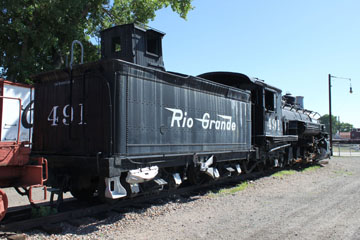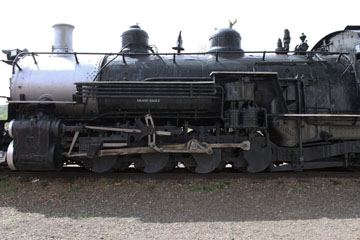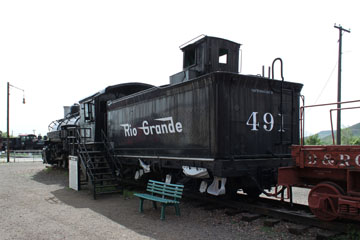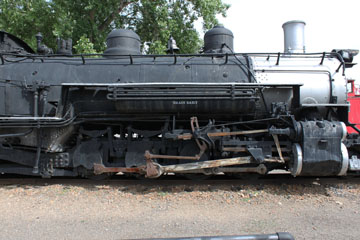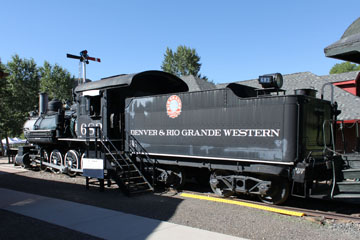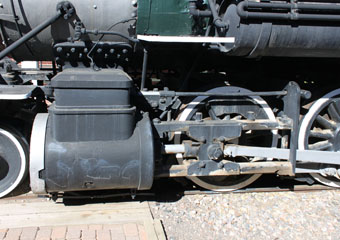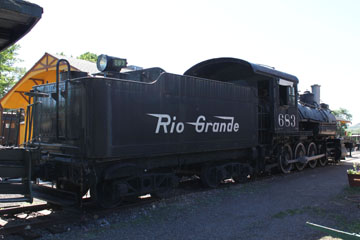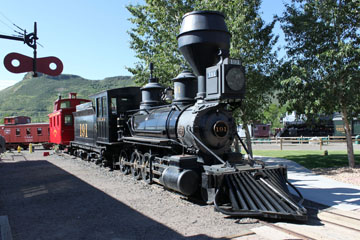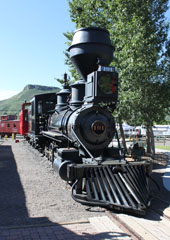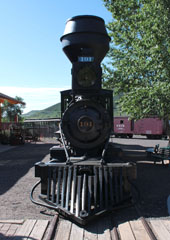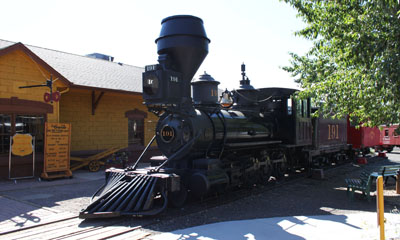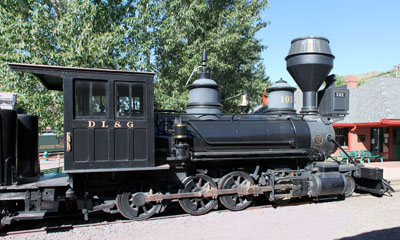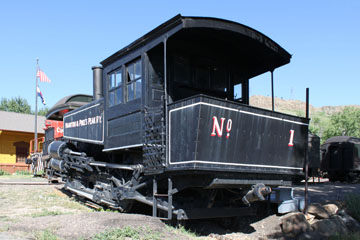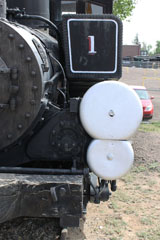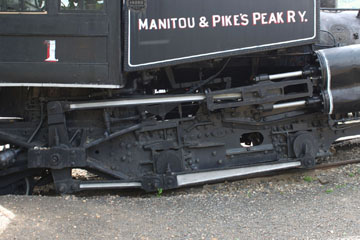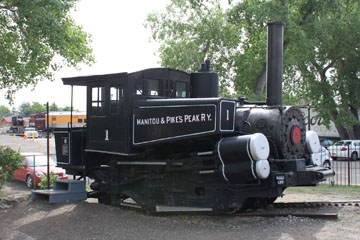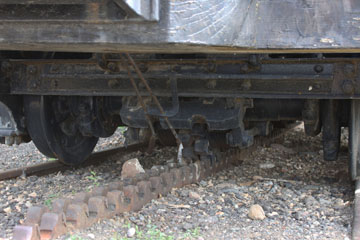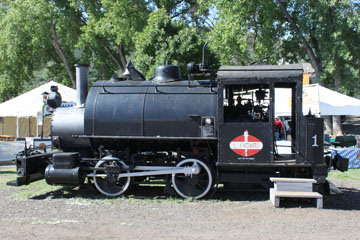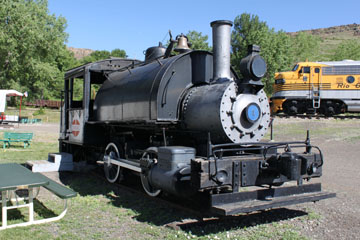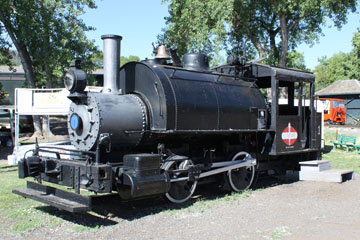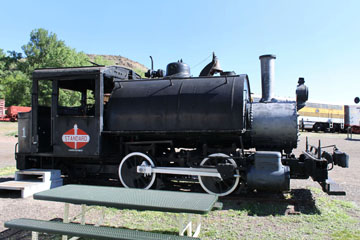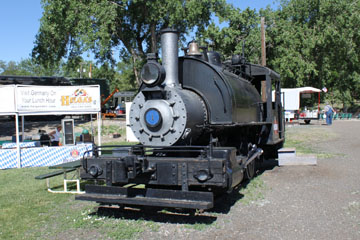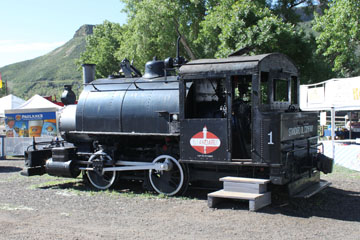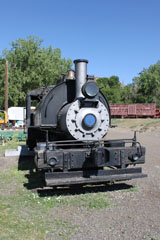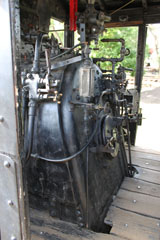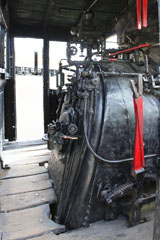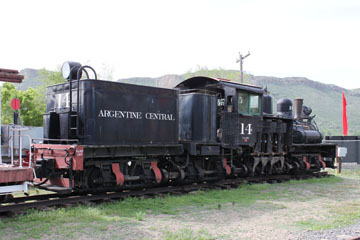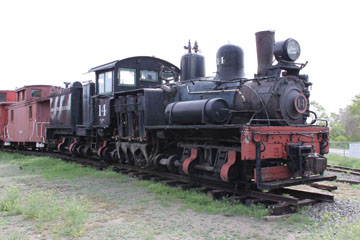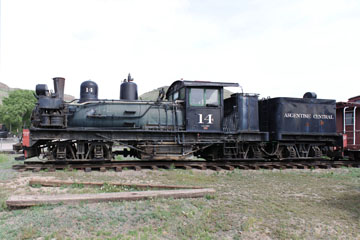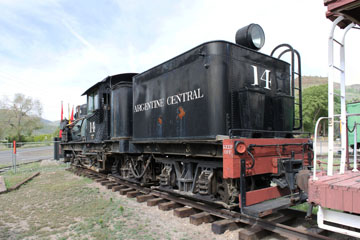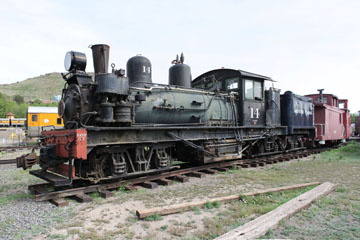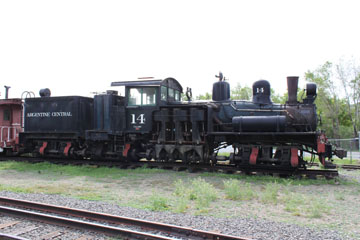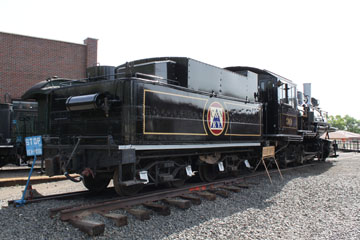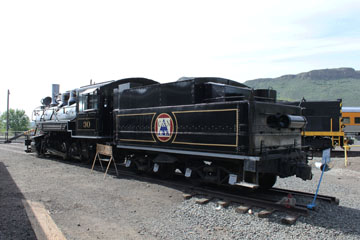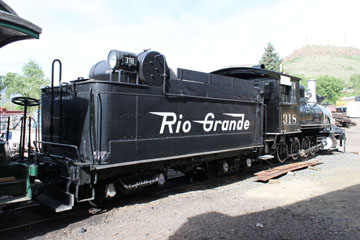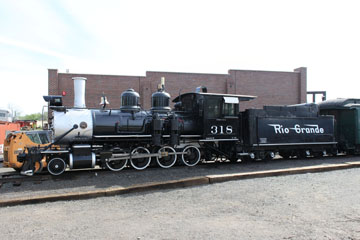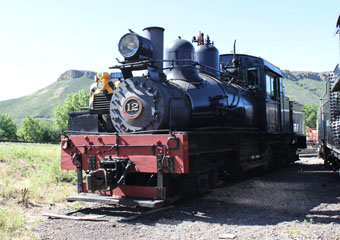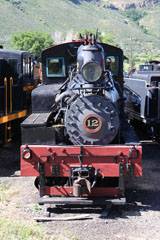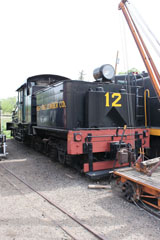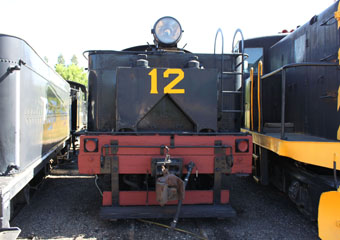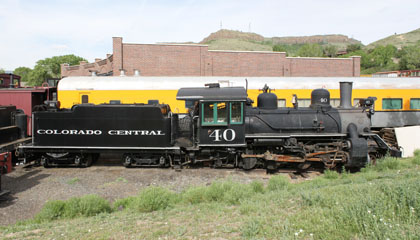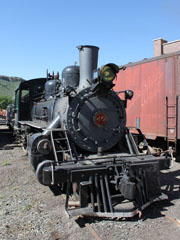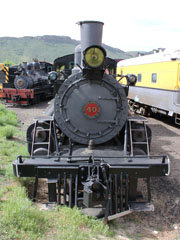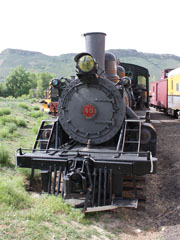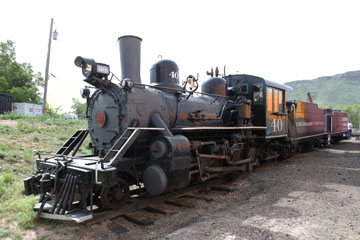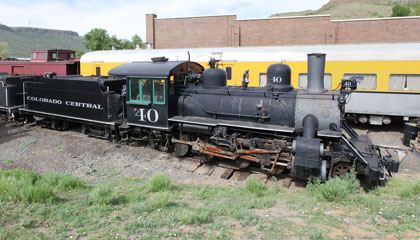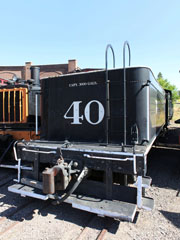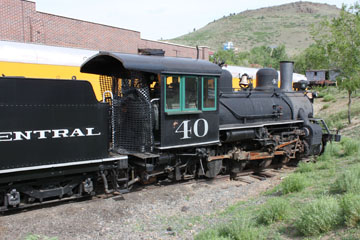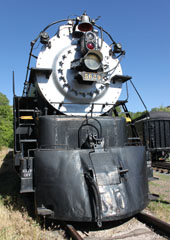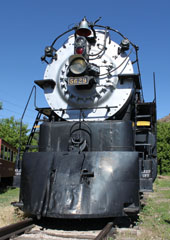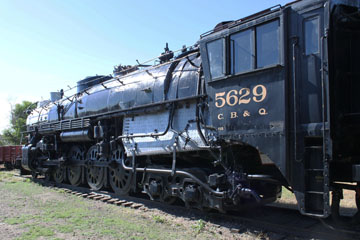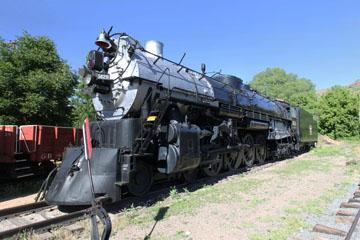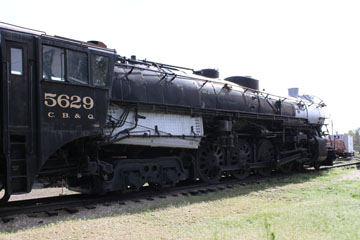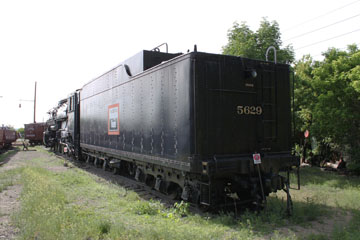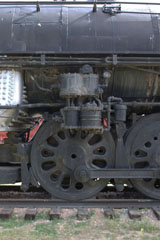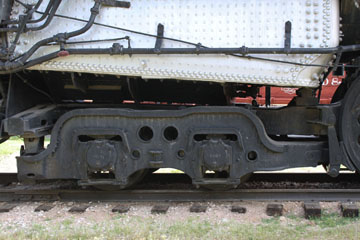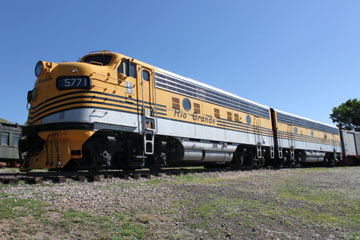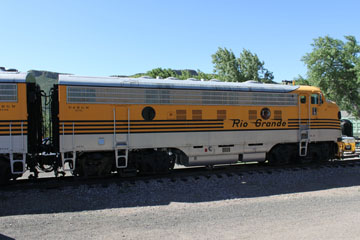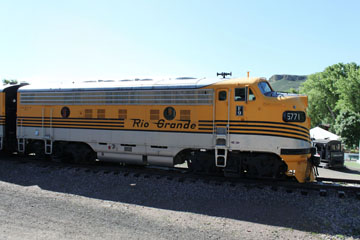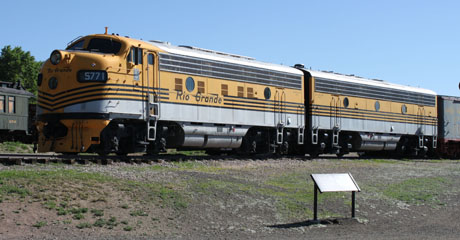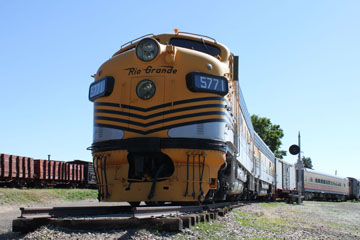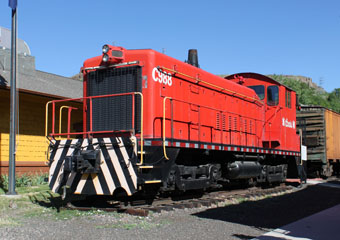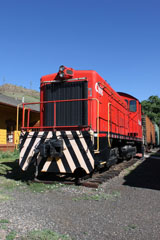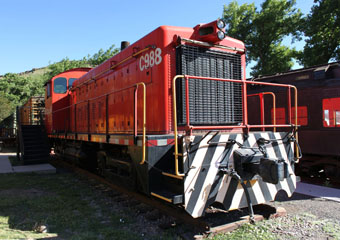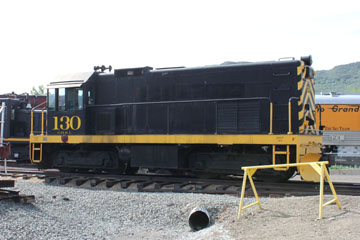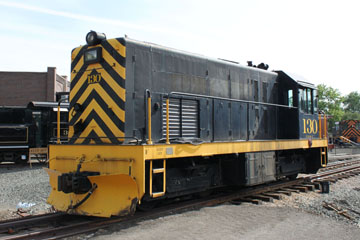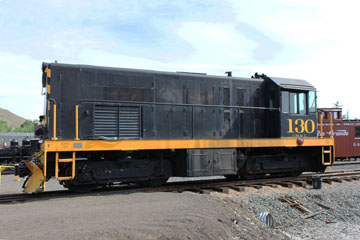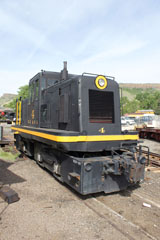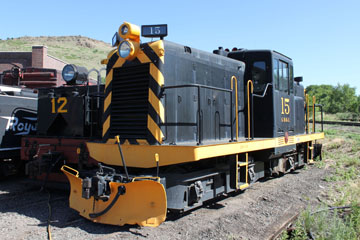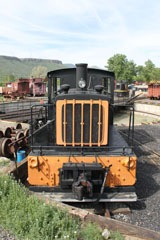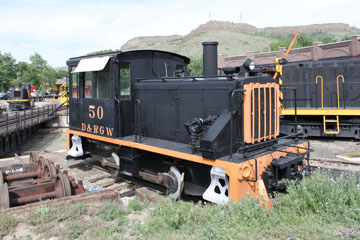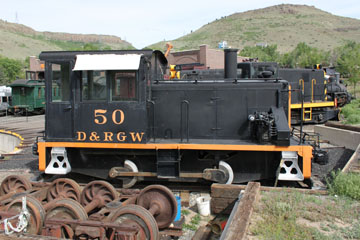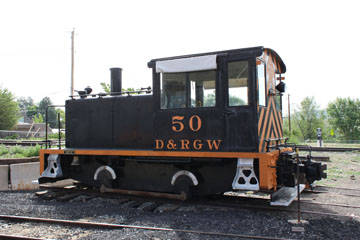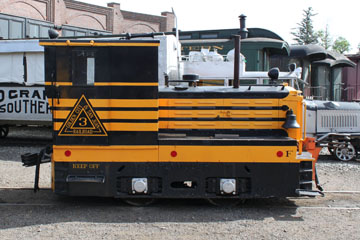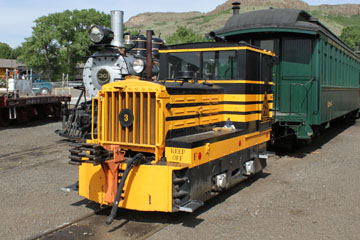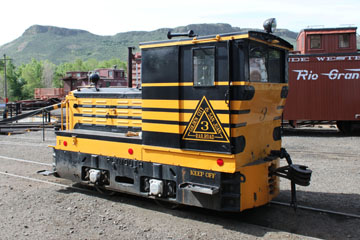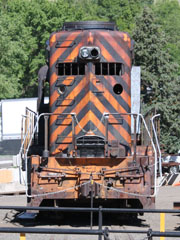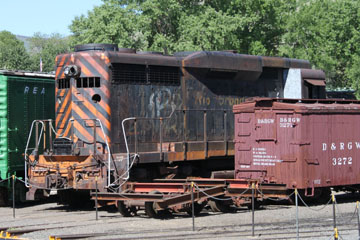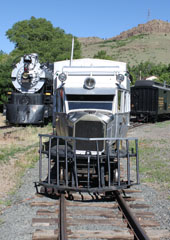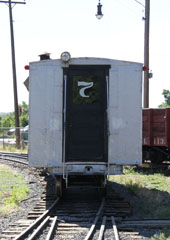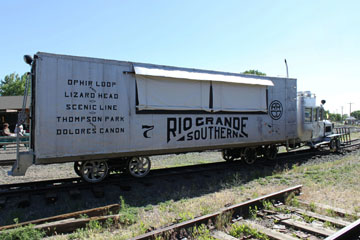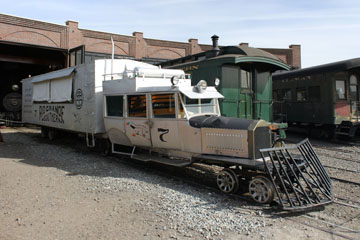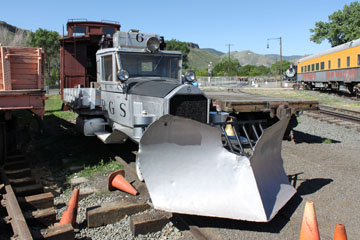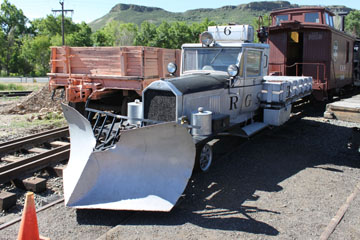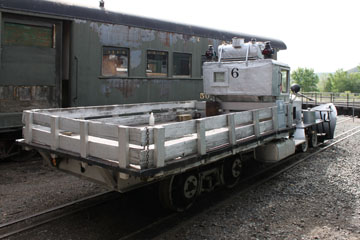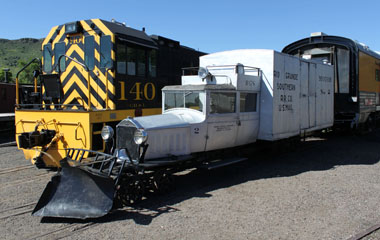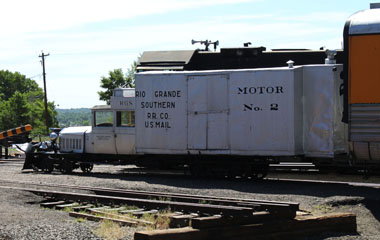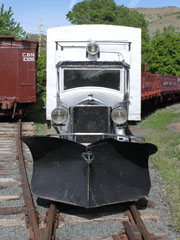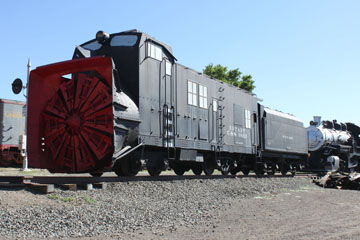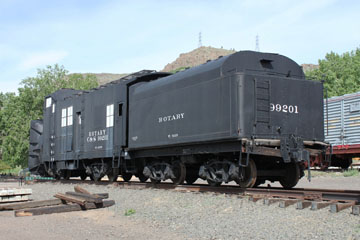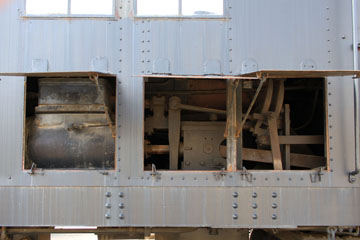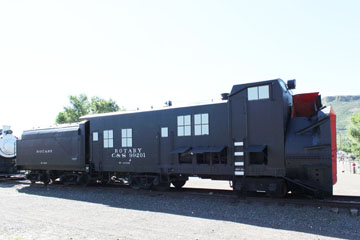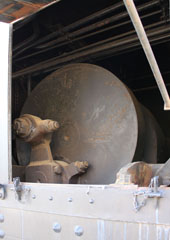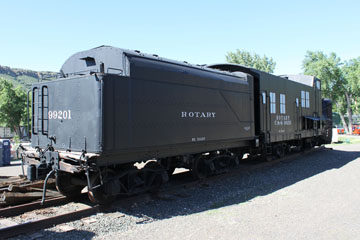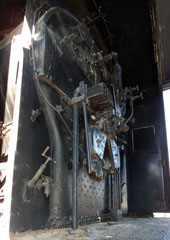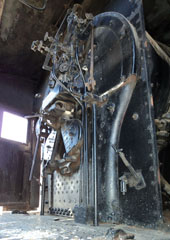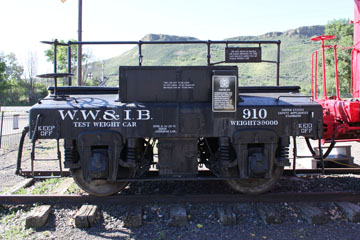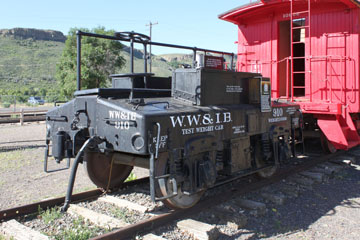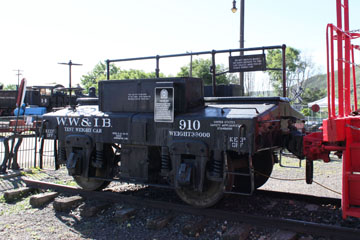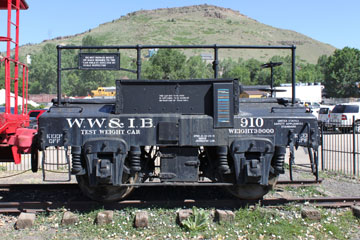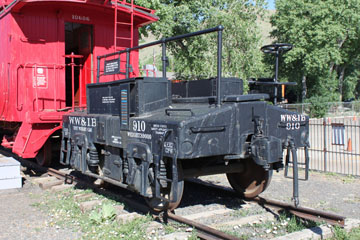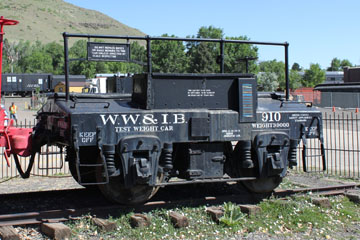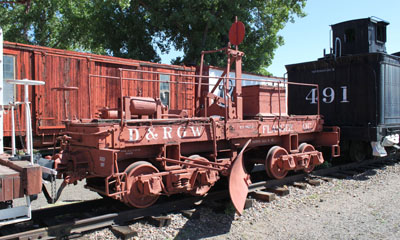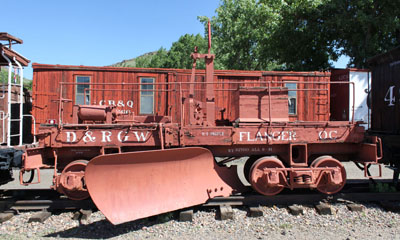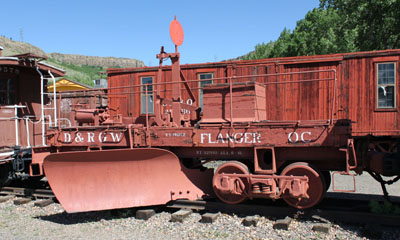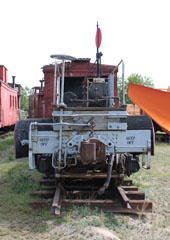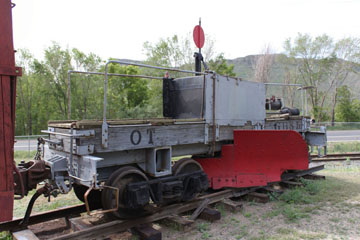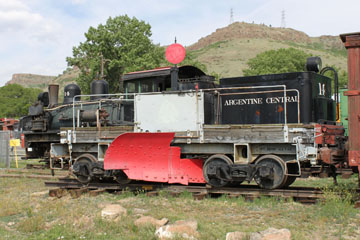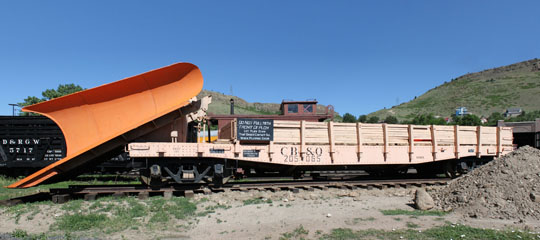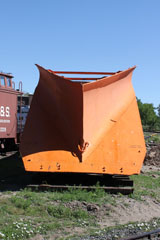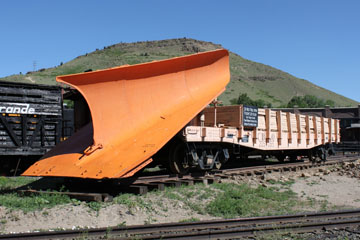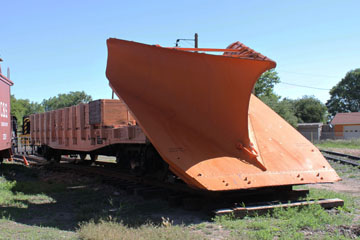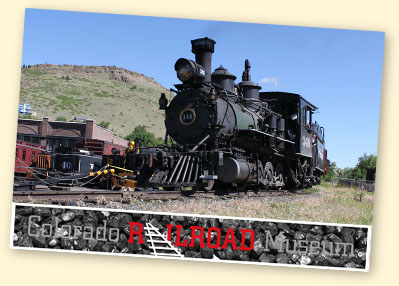

In the 1940s and early 1950s, many Colorado narrow gauge railroads went out of business: the Uintah Railway Company closed in 1939, the Rio Grande Junction in 1941, the Silverton Northern in 1942, the Colorado & Southern in 1943, the Midland Terminal in 1949 and the Rio Grande Southern in 1951.
During these years, Robert W. Richardson began collecting rolling stock, records and other equipment from the defunct railroads in an effort to preserve the state's rich railroading history. His collection quickly outgrew the space at his original museum in Alamosa, CO, and in 1958, with the help of his friend Cornelius Hauck, he moved the museum to Golden. There, with the help of volunteers, he built a replica narrow gauge railroad depot to serve as the main building and laid track for fifty pieces of equipment. Since then, the Colorado Railroad Museum has continued to acquire historic artefacts and expand facilities on the site.
The museum is located at 17155 W 44th Avenue in Golden, CO, about seventeen miles from downtown Denver. It is open 9.00-5.00 every day except Thanksgiving Day, Christmas Day and New Year's Day. I have been to the museum a couple of times and the images on this page are from both visits.

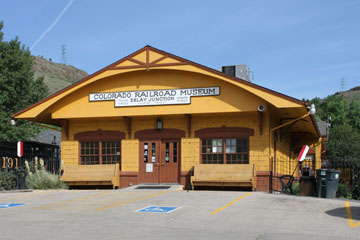
The main building, ticket office and gift shop is a replica of an 1880s style depot building. Dedicated in 2000, it is a composite of what a late nineteenth century railroad would put up at a small division point. It also houses a collection of rare photographs, artefacts and documents, as well as model cars and locomotives, and a reconstructed telegrapher's office staffed by a mannequin!
The downstairs exhibition hall features seasonal and travelling displays, the Denver HO Society's "Denver and Western" operating model train layout is south of the exhibition hall, and the Robert W. Richardson Library contains over ten thousand railroad related books.
The Denver Garden Railway Society has its
G-scale, railway exhibit at the museum. They operate on Saturday mornings throughout the year. The museum also holds "Ride the Rails" days on Saturdays when visitors can ride behind historic engines on a 3⅓ mile 36" gauge oval track around the museum grounds.
Lastly, the Cornelius W. Hauck Roundhouse, completed in 2000, is where maintenance and restoration work is carried out. Visitors can view the operation from a glassed in walkway inside the perimeter of the building.

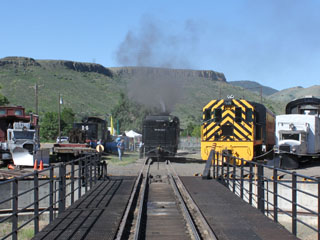

Above, Consolidation (2-8-0) type Denver & Rio Grande #346 standing in the yard prior to the day's "Ride the Rails".
The locomotive was built in 1881 for the narrow gauge D&RG as class 70 #406 "Cumbres" by Burnham, Parry, Williams & Co., an early incarnation of the Baldwin Locomotive Works. It started work on the steep grades of Marshall Pass and along the Gunnison Extension (Third Division) with the other Class 70s. In 1903, it moved to the San Juan Extension to Chama, coping with the 4% grades of Cumbres Pass, but also worked over most of the D&RG 36" narrow gauge system.
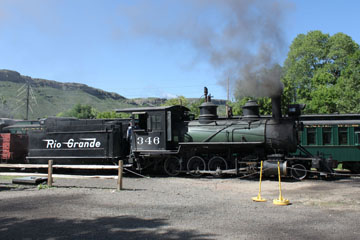
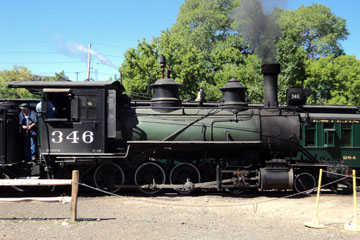
Above, waiting for the passengers to load.
#406 was re-numbered #346 and reclassed C-19 in July 1924 three years after the D&RG was taken over from bankruptcy by the newly formed Denver & Rio Grande Western. Early in 1936, it was transported by standard gauge flat car to the Colorado & Southern Railway in Denver, along with #343 and #345, and started work between Denver and Leadville. On 25th July that year, #346 was working as a helper out of Como on an eastbound freight and, after cutting off at the top of Kenosha Pass, it headed east running light towards Denver. However, the engineer lost control of the locomotive, which overturned on a curve just below the summit.
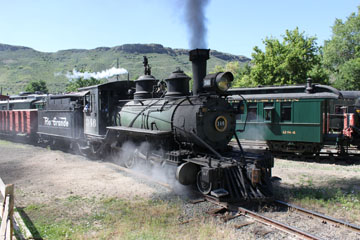
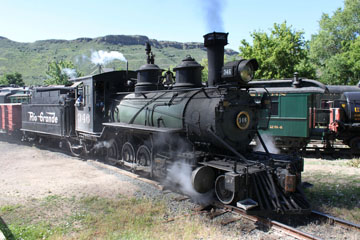
Above, #436 gets under way.
In the Kenosha derailment, the engine suffered significant cosmetic damage, although the
engineer was killed. After repairs in the Burlington/C&S Denver shops, #346 returned to service with a new steel cab, new steam dome cover and sand dome, and various other replacement parts. It worked on the C&S until April 1937, when it was shipped back to the D&RGW along with #343 and #345. In 1947, the locomotive was sold to the Montezuma Lumber Company to haul lumber on a five-mile line between McPhee and Dolores, CO. The following year, a fire destroyed the McPhee sawmill and ended #346's operational service life.
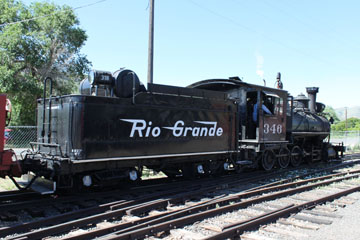
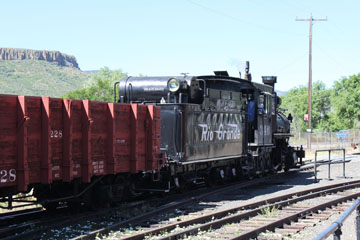
Above, #436 returns to the yard after its trip.
Following the sawmill fire, the engine was stored on a spur track in Dolores for nearly two years, It was sold to Booker Junkyard in March 1948 and then to the Narrow Gauge Motel in Alamosa, CO. In 1958, #346 was sold to Robert Richardson of Alamosa, CO, who then sold it to the museum. After extensive work the locomotive returned to steam in 2007. A coal burner, #346 weighs 74,260 lbs, 64,000 lbs on its 36.5" drivers. With Stephenson valve gear, 16" x 20" cylinders and operating at a boiler pressure of 160 psi, it delivers 18,947 lbs tractive effort. The tender weighs 530,000 lbs light and has a capacity of 2,500 gallons of water and 6 tons of coal.


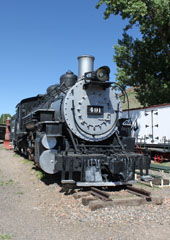
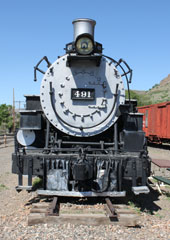

This 2-8-2 Mikado type locomotive has had a varied career.
Originally numbered #1126, it is one thirty standard gauge locomotives built in 1902 by Burnham, Williams & Co., an early incarnation of the Baldwin Locomotive Works, as D&RG Class 190 Vauclain compound Consolidation (2-8-0) type locomotives with 17" x 30" high pressure and 28" x 30" low pressure cylinders (#1101-#1130). They were modified in 1907 as simple-expansion locomotives with 21"x 30" cylinders. #1126 was renumbered #1026 and redesignated a Class C-41 in 1924, three years after the D&RG was taken over from bankruptcy by the newly formed Denver & Rio Grande Western.
#1026 was then one of two C-41s (#1026 & #1027) rebuilt by the Rio Grande's Shops in Burnham, CO, as 36" gauge K-37 class locomotives in 1928 (renumbered #490 & #491). This was a relatively rare example in which standard-gauge locomotives were converted to operate on a narrow gauge railroad.
Trying to put as much power as cheaply as possible over a single set of wheels on a 36" gauge, the railroad added a trailing axle under the C-41's firebox and moved the wheels 1½ feet closer together in a new frame.
The rebuilt locomotives incorporated many new components, such as smaller drivers (down from the C-41's 54" to 44") as well as superheating. They also demonstrated the benefits of using an outside frame, which allowed a large boiler of standard gauge size to be fitted to a 36" gauge engine.
The K-37s weighed 187,250 lbs, down from the
C-41's 188,095 lbs, but increasing the weight on
the drivers from 148,280 lbs to 163,445 lbs. With a 46.6 sq ft grate and total heating surface of 2,102 sq ft, including 495 sq ft superheating, the K-37s operated at a boiler pressure of 200 psi delivering 37,091 lbs tractive effort compared to the C-41's 39,886 lbs.

The rebuild included removing boiler tubes as part of the firebox overhaul and installation of 46 sq ft of thermic syphons. As the only D&RGW narrow gauge steam locomotive to have thermic syphons, the K-37s became something of a favourite with firemen.
The newly rebuilt locomotives initially worked out of Salida to Gunnison, CO, and up the D&RGW Crested Butte Branch as well as the Monarch Branch. They also worked from Alamosa to Antonito, CO, over Cumbres Pass to Chama, NM, and on to Durango and the Farmington Branch.
#491 was donated to the Colorado State Historical Society at Alamosa, CO, by the D&RGW in 1972 and was moved to the Colorado Railroad Museum in 1985.

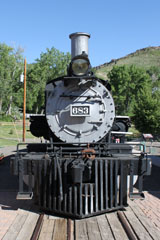
This is the only surviving standard gauge D&RGW steam locomotive.
It was built in 1890 by Burnham, Parry, Williams & Co., an early incarnation of the Baldwin Locomotive Works, as D&RG Consolidation (2-8-0) Class 113 #583. When the D&RG was taken over by the newly formed Denver & Rio Grande Western, it was renumbered #683. Three years later, it was redesignated as a Class C-28.
It was eventually replaced in main line service by larger locomotives and was last used by the D&RGW as a switcher in Salida.
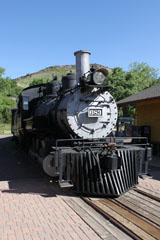
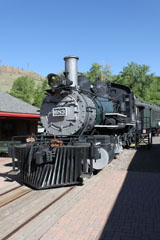
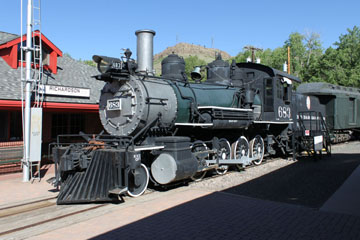
In 1947, the locomotive was sold to the San Luis Valley Southern Railway Company in Blanca, CO, where it was renumbered #106 and was used until 1956.
The SLSV was a narrow gauge shortline chartered in 1909 to build south from the D&RG's standard gauge La Veta Pass line at Blanca, CO, to Taos, NM. The line never made it that far, however, ending at Jaroso, CO, just north of the New Mexico border in 1910. It hauled farm produce, fertiliser and volcanic scoria until abandoned in 1958.
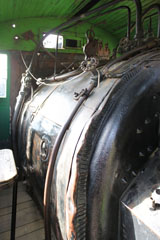
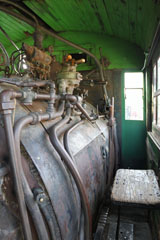
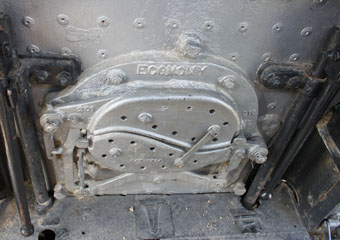
Top left, a view from the fireman's side of the cab. Top right, a view from the engineer's side. Lower photo, note the clam shell fire doors dated 1914. A coal burner with a 24.94 sq ft grate, 160.19 sq ft firebox and total heating surface of 1,675 sq ft, #683 operated at a boiler pressure of 140 psi delivering 24,835 lbs tractive effort. The engine weighs 115,000 lbs, 99,700 lbs on its 47" drivers.
#106 was sold to the museum by the SLSV and arrived in 1962. It has been restored to a D&RGW livery and the number it bore as a
C-28. The left side is painted as it would have been in the 1930s and the right side as it would have appeared in the 1940s.

In 1902, the locomotive was sold to A. A. Bigelow & Co., in Washburn, WI, where it was renumbered #7. It then retained that number when it was sold to the Robbins Railroad Co., in Rhinelander, WI, in 1906. After being transferred to the Thunder Lake Lumber Co., in 1919, #7 was finally retired in 1932 and was donated to the City of Rhinelander, WI.
In February 1973, the locomotive was transferred to the Colorado Railroad Historical Foundation for cosmetic restoration and display at the museum as it appeared when it worked for the Denver Leadville & Gunnison as #191.
This is the oldest surviving authentic Colorado steam locomotive in the state.
It was one of eight 36" gauge Consolidation type
(2-8-0) locomotives built in 1880 for the Denver, South Park & Pacific Railway Co., (#50-#57) by Burnham, Parry, Williams & Co., an early incarnation of the Baldwin Locomotive Works. Originally #51, in 1885, it was renumbered #191 and it retained that number when the DSP&P was sold to the Denver, Leadville & Gunnison Railroad Co., in 1889. Ten years later, when the DL&G was consolidated into the Colorado & Southern, it was renumbered #31. Soon after, it was sold to Edward Hines Lumber Co., in Park Falls, WI, where it was renumbered #102.
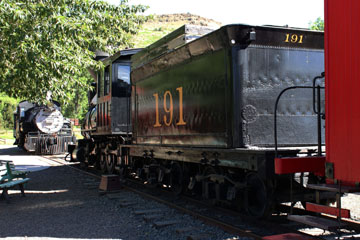
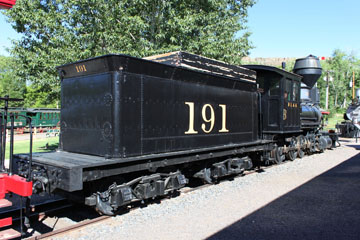
The tender weighs 45,933 lbs light and has a capacity of 5 tons of coal and 16,000 gallons of water.
The engine was designed to operate on light rails (minimum 22 lbs). It weighs 61,748 lbs, 53,748 lbs on its drivers, and has a driver wheelbase of 11' 4" and overall engine wheelbase of 17' 10". To help handle the sharper curves on narrow gauge rails, both the locomotive's second and third drivers are "blind" (i.e. flangeless).
With a 13.8 sq ft grate, 93.5 sq ft firebox and total heating surface of 816 sq ft, #191 operated at a boiler pressure of 150 psi delivering 13,956 lbs tractive effort.

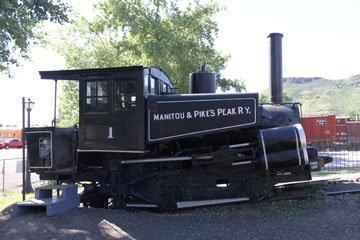
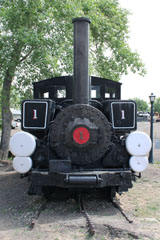
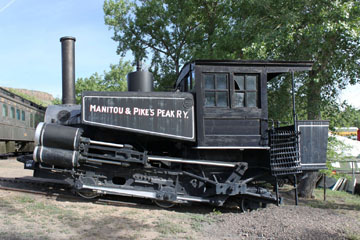
Burnham, Williams & Company/Baldwin, built this 0-4-2T (Tank) locomotive in 1890 for the Manitou & Pike's Peak Railway Co. The company operated rack and pinion lines out of Manitou Springs, CO, up to scenic lookouts on Manitou Mountain and Pike's Peak.
The engine started life as a simple expansion locomotive named "John Hurlburt" but, in 1893, it was converted to a Vauclain compound and numbered #1. Vauclain himself travelled to the line to deal with operational issues with the original engines in their pre-compounding state.
They have the less common 15" x 22" low pressure cylinders on the top and 10" x 22" high pressure cylinders on the bottom.
A single valve cylinder is on the inside between the two main cylinders and the smokebox.
The 8.9 mile standard gauge line was built as a tourist-only line beginning in 1889, with a limited service to the Halfway House Hotel completed by 1890. The 14,110 foot summit of Pikes Peak was reached the following year.
The Manitou Incline was built in 1907 for use in constructing city water lines and a hydroelectric plant, after which, the M&PP took over the cable car as a tourist operation. The lower terminus was next to the Cog Railway station in Manitou Springs, but the line was closed by a rock slide in 1990 and has not reopened.
The rack system invented by the Swiss engineer Roman Abt was used on the track, which reached
a maximum grade of 25% in places. It consists of two side by side steel racks with alternating upward pointing teeth that mesh with the locomotive's drive pinions on the two 22½" front drive wheels.
A coal burner, #1 weighs 52,680 lbs and operated at a boiler pressure of 180 psi. The locomotives' boilers were inclined relative to the wheelbase to keep them level on the average 16% grades on the climb up Pike's Peak.
During the 1930s the M&PP began investing in diesel power, although #1 continued working on the grade until 1941. At some later date, it was donated to the Cheyenne Mountain Zoo in Colorado Springs, CO. Then, in 1979, it was donated to the Colorado Railroad Historical Foundation for display at the museum.
Four of the original six M&PP compounds have survived. As well as #1 at the Colorado Railroad Museum, #2 is on display in Memorial Park in downtown Manitou Springs, CO (you can see it on the MPP #2 page of this website). #4 is still operational and steamed at the railroad's centennial in 1991. It is in storage at the railway's depot along with #5.

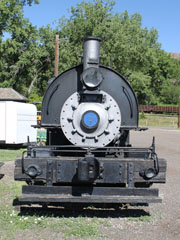
This 0-4-0T (Tank) locomotive was one of five built by Alco in 1920 for stock.
It was quite a common practice for locomotive builders to manufacture small numbers of standard designs in this way so that they could be quickly delivered to interested purchasers. The 0-4-0T locomotive was also a common type used for switching in industrial plants, and this one was shipped to the Standard Oil Company of Indiana in January 1921 to work at the company's Casper, WY, refinery.
It transferred to the American Oil Company in 1960 and worked in Casper until 1962, when it was donated to the museum.

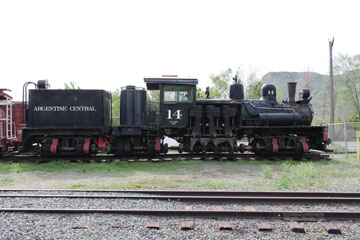
The locomotive was built in 1916 by the Lima Locomotive Works in Lima, OH, for the Sierra Nevada Wood & Lumber Co., in Hobart Mills, CA, as #10. It weighs 117,000 lbs and has 11" x 12" cylinders and 32" drivers. An oil burner, it operated at a boiler pressure of 200 psi delivering 25,830 lbs tractive effort.
In 1937, Sierra Nevada Wood & Lumber went bankrupt and their equipment, including #10, was sold to the scrap dealer Hyman-Michaels in Chicago, IL. Two years later, the locomotive was sold to West Side Lumber in Tuolumne, CA, and renumbered #14. It was sold to Hal Wilmunder and became Camino, Cable & Northern #4 at Camino, CA, in 1965. It then went to the Colorado Narrow Gauge Railroad as #14 in Central City, CO, in 1974, and finally moved to Silver Plume, CO, to become Georgetown Loop #14 in 1981.
In 2004, following an impasse with the Colorado Historical Society, which owns the land on which the Georgetown Loop operates, the railroad announced it would cease operations. It planned
to move to the Royal Gorge Route in Cannon City, CO, building a third rail so both narrow and broad gauge trains could run. Fortunately, the problems were ironed out and the Loop still operates although, in late 2004, #14 transferred to the Colorado Railroad Museum.

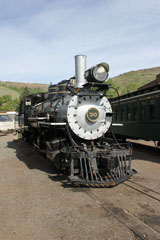
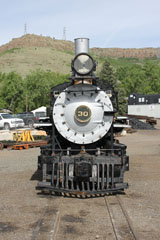
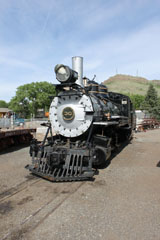
When it was built for the Colorado & North Western in 1898 by the Brooks Locomotive Works in Dunkirk, NY, (later part of Alco), this was one of the three largest narrow gauge locomotives in the world (#30-#32).
To set the steam chests under the 60" diameter smokebox, they were to be canted outward. This had been done on some of Brook's recently built standard gauge engines, but it caused major lubrication problems and, of the three, only #30 had the sloping steam chests, as can be seen in the three photos above.
The C&NW ran west from Boulder, CO, up the Boulder Canyon to Ward and Eldora. Freight traffic was not enough to keep the railroad profitable, so it advertised itself as the "Switzerland Trail of America" to entice tourist revenue, but finally went bankrupt in 1909. Its successor, the Denver, Boulder & Western had an even shorter life, going bankrupt in 1919.
In 1920, the operation was bought by Morse Brothers Machinery & Supply Co., in Denver, which traded the three engines to the Colorado & Southern in 1921.
Renumbered #74 and classified as a B-4-F, the locomotive worked on the C&S until 1943, when the last of its narrow gauge trackage was abandoned. Returned to Morse Brothers, it sat until 1948 when it was bought by the Rio Grande Southern. It had a brief life on the RGS until operations ceased in 1951 and, the following year was donated for display in the City of Boulder, CO. In 2012, after a cosmetic restoration, it was leased to the museum.
#30 weighs 945,000 lbs. With
16" x 20" cylinders, a 19.3 sq ft grate, 130 sq ft firebox and total heating surface of 1,289 sq ft, it operated at 180 psi delivering 21,172 lbs tractive effort. The original inside Stephenson valve gear was replaced with Walschaert by the C&S.

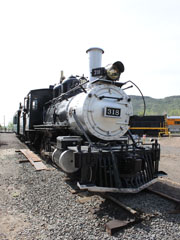

Built as Florence & Cripple Creek #8 by Baldwin in 1896, this locomotive was named "Goldfield". It was one of eight 36" narrow gauge 2-8-0s owned by the railroad hauling freight north from a D&RG connection in Florence, CO, up Phantom Valley to the Cripple Creek mining district west of Pikes Peak. Ore then came south from the mines for milling in Florence or transfer to the D&RG to mill in Pueblo, CO.
One of the first railroads in this mining district, the F&CC also rostered six 4-6-0 Ten Wheelers for passenger services.
The line was finally abandoned in 1917 and the equipment was quickly sold to other narrow
gauge operators including the D&RG, which bought six of the eight original Consolidations. #8 was renumbered #428 by the D&RG and then #318 by the D&RGW in 1924. In 1953, it was sold to Morse Brothers Machinery & Supply Co., in
Denver, CO, and the following year went to Alamosa, CO, for display at the Narrow Gauge Motel. It was bought by the Colorado Railroad Museum in 1958.
Weighing 72,000 lbs, 64,000 lbs on its 38" drivers, it has 16" x 20" cylinders, an 14.6 sq ft grate and 87.5 sq ft firebox. Operating at a boiler pressure of 145 psi delivering 16,606 lbs tractive effort.

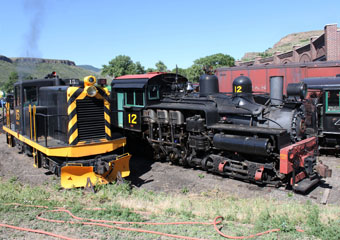
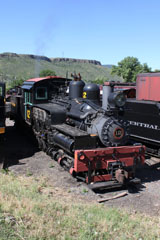
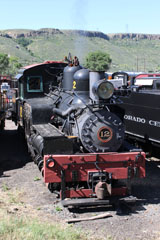
#12 is another oil burning 3 truck Shay that transferred to the museum in 2004 from the Georgetown Loop in Silver Plume, CO.
It was built by Lima in 1927 for the 36" narrow gauge Swayne Lumber Co., in Oroville, CA, as #16. In 1940, it was sold to West Side Lumber in Tuolumne, CA, and renumbered #12. At some point, the locomotive was then sold to Francis Cottie to become West Side & Cherry Valley Railroad #12 and then, in 1986, it was sold to the Georgetown Loop Railroad. Along with West Side Lumber #14, DRGW #346 and IRCA #40, #12 is one of the locomotives used to haul passenger trains on the museum's "Ride the Rails" days.
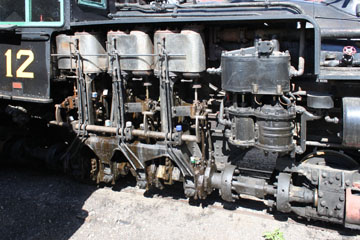
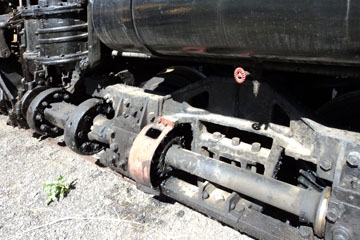
Above top, the three vertically mounted 11" x 12" cylinders. Lower photo, the cylinder rods drive a cam shaft connected to a horizontal drive shaft. The shaft has a universal joint and square sliding slip joints to accommodate the trucks' swivelling motion. Drive was transferred to the 32" wheels by bevel gears. #12 weighs 133,500 lbs. Operating at a boiler pressure of 200 psi, it delivers 25,830 lbs tractive effort.
You can see more Shays on the Cass Scenic Rail Road page of this website, on the North Carolina Museum of Transportation, the B&O Railroad Museum Roundhouse, Steamtown, Mid-Continent Railway Museum and Railroad Museum of Pennsylvania Train Shed pages.

The running gear was rebuilt in the off season of 2003-04, but #40's last run was on 4th October 2004 before moving to the Colorado Railroad Museum.
As it is in such good condition, however, it may steam again at the museum.
#40 is another of a number of locomotives moved from the Georgetown Loop to the museum in 2004. This Consolidation type (2-8-0) was built by Baldwin for the Guatemala Railway Co., in 1912 as #50. Merged into the International Railways of Central America in 1913, it was renumbered #40 in 1928. In 1972, it was sold to the Colorado Central Narrow Gauge Railway Co., in Central City, CO, and five years later moved to Silver Plume, CO, as Georgetown Loop #40.
The locomotive worked at Georgetown until transferred on a five year lease to the White Pass and Yukon in 2000 for that railroad's centennial celebration.
Unfortunately, #40 proved too heavy for the WP&Y's loading gauge and it was returned to Colorado the following year, stopping at the Colorado Railroad Museum from December 2001 through April 2002, where it was operated on two occasions.
#40 then returned to the Georgetown Loop in mid 2002 and operated for the next two seasons.

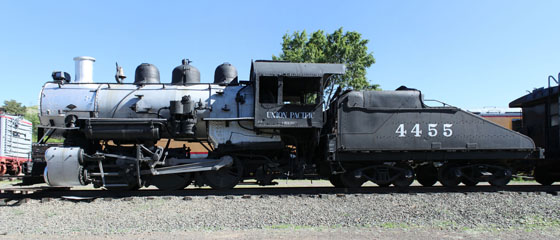
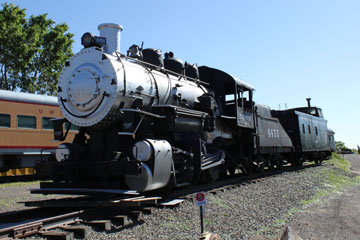
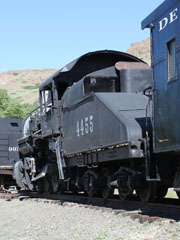
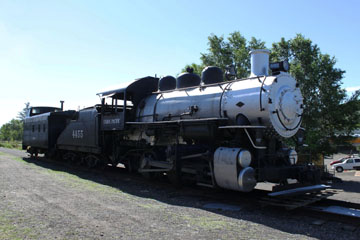
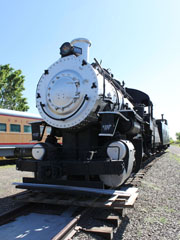
Union Pacific Class S-6 0-6-0 switcher #4455 was built by Lima in 1920. It was sold to Monolith Portland Midwest Company, Laramie, WY, in 1949.
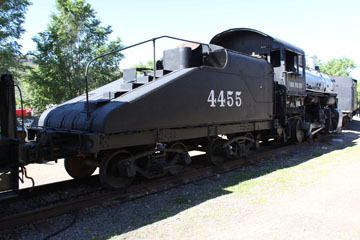
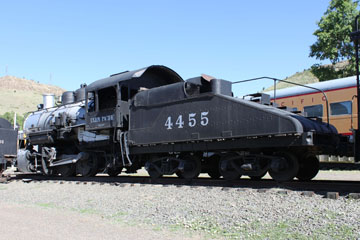
Monolith Portland retired #4455 in 1970 and donated it to the museum. Weighing 159,000 lbs, with 21" x 26" cylinders and 51" drivers, the locomotive operated at a boiler pressure of 180 psi delivering 34,400 lbs tractive effort.
The 0-6-0 dominated switching duties in US railroads up to WWI, although heavier freight loads had brought more orders for 0-8-0s. At the same time, old road engines were often diverted to switching, either as-built or after their leading and trailing trucks were removed. After WWI, the success of the USRA 0-8-0 design reduced demand for 0-6-0s. Although orders did continue right into the 1940s, they were generally used on lighter duties and in smaller yards.

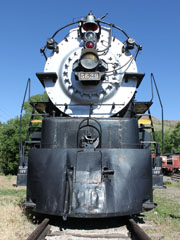
The Chicago, Burlington & Quincy Railroad bought eight Northern
(4-8-4) type locomotives from Baldwin in 1931 (#5600-#5607).
Designated Class O-5, the new locomotives had Elesco feedwater
heaters and Timken
roller bearings. They were used to haul both freight and passenger services and proved very successful.
The CB&Q then made some modifications to the design and built thirteen of its own at its West Burlington Workshops in 1937 (#5608-#5620). Designated Class O-5A the new locomotives used Baldwin boilers but were fitted with Worthington SA feedwater heaters.
A further fifteen were built in 1939 (#5621-#5635), bringing the roster to thirty-six. You can see two of this last batch on the CBQ #5631 and CBQ #5633 pages of this website. Many O-5s were subsequently rebuilt to O-5A standards with Boxpok drivers, roller bearings, lightweight rods, vestibule cabs and solid cast pilots. Some, like #5629, were converted to burn oil.
The Northern was arguably the optimum steam locomotive for passenger service and fast freight. The eight drivers could operate on most US main lines, the four wheel trailing truck supported a large firebox for maximum firebox and boiler capacity, and the four wheel leading truck gave good riding and tracking.
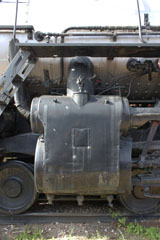
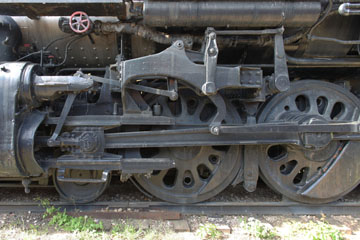
The Baldwin built O-5 engines weighed 461,000 lbs, the O-5as 473,700 lbs but, except for the Worthington SA feedwater heaters, the locomotives were identical. They had 28" x 30" cylinders and were equipped with Baker valve gear and 74" drivers with a driver wheelbase of 19' 3" and engine wheelbase of 45' 6".
The grate was 106.5 sq ft and the 433 sq ft firebox heating surface included 45 sq ft of arch tubes and an 83 sq ft combustion chamber. With an additional 2,403 sq ft of superheating the total heating surface was 7,628 sq ft.

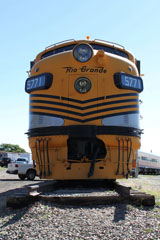
F9 #5771 is coupled with cabless F9 B unit #5762 (originally DRGW #5753).
The D&RGW bought four F9 A units from EMD in 1955 (#5531, #5571, #5771 & #5774) and four F9 B units (#5772, #5773, #5753
& #5763). #5771
hauled freight and passenger services between Denver, CO, and Salt Lake City,
UT.
#5771 and its two B units (#5772 & #5773) were also the primary power for the Rio Grande Zephyr, the last non-Amtrak long distance train in the US after the Southern ceased running the Southern Crescent from New Orleans in 1979.


Between December 1983 and March 1984, they powered the D&RGW'S Ski Train, which ran fifty-six miles from Union Station in Denver, CO, to the ski resort of Winter Park and return each day. The train was inaugurated in 1940 and climbed about 4,000 feet passing through thirty tunnels including 6.2 mile Moffat Tunnel, the highest railroad tunnel in the US.
After their short stint on the Ski Train, the two units performed a little more general service and were then retired. At that time, #5571 was the last operational F unit on the Rio Grande. They were donated to the Colorado Railroad Museum by the Southern Pacific, successor to the D&RGW, in 1996.
#5771 is 50' 8" long and weighs 230,000 lbs. #5762 is 50' long and weighs 228,00 lbs. A Winton 567C 16 cylinder prime mover drove a 1,750 hp GM D12D generator in both units to power four GM D37 traction motors delivering 40,000 lbs continuous tractive effort at 9.3 mph with a top speed of 65 mph.
Ninety-nine F9 A units and one hundred and fifty-six B units, including forty-six built by GMD in Ontario, Canada, were produced by between 1953 and 1960. They were the last in a long line of EMD units designed to haul freight (the "F" stood for freight) starting with the FT in 1939. In total, four thousand, seven hundred and thirty-six F A and two thousand, nine hundred and six F B units were outshopped.
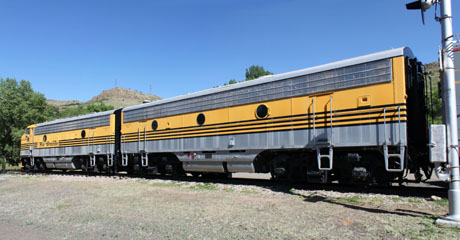
You can see BN F9 BN-1 and BN-2 on the Illinois Railway Museum Yard page of this website.

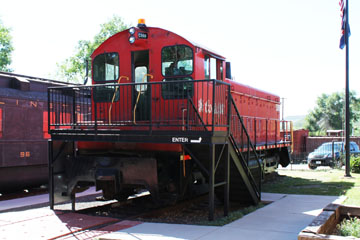
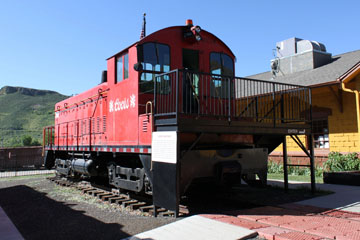
ROCK #550 was built in 1957. It has an 800 hp 8 cylinder EMD 567C prime mover powered a GM D15C generator to drive four GM D37B traction motors. Weighing 230,000 lbs, it delivers 36,000 lbs continuous tractive effort at 11 mph and has a top speed of 65 mph.
Two hundred and seventy-four SW900s were built by EMD from 1954 to 1965 as well as ninety-seven by GMD in Montreal, Canada into 1969. They followed after earlier models such as the SW9, SW8 and SW1 had completed production. Their hp rating was lower than their predecessor, the SW9, which may explain why they did not sell as well: by comparison over eight hundred 1,200 hp SW9s were built.


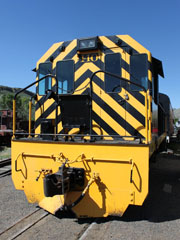
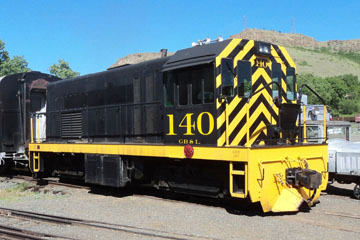
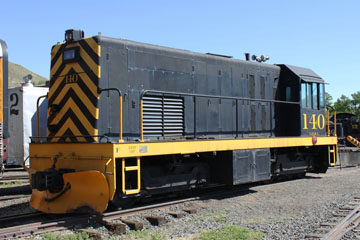
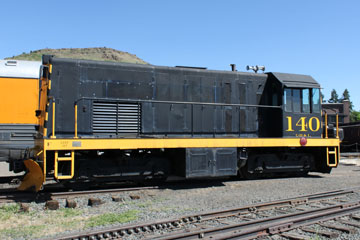
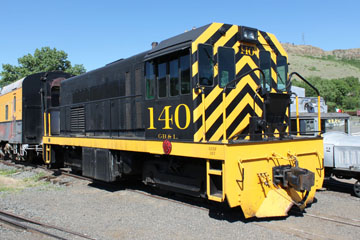
This 1956 GE 52-Ton switcher worked for US Gypsum in Plaster City, CA, as #1403.
It was sold to the Georgetown Loop in 1992, and is another unit moved to the museum in 2004.
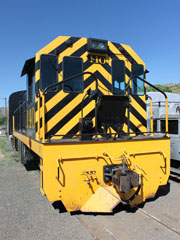
The Georgetown, Breckenridge & Leadville Railway was incorporated in 1880 to connect Georgetown, Breckenridge and Leadville, CO. Work started at Georgetown in 1883, with a 6% grade to Silver Plume on the first stage to connect with the Denver, South Park & Pacific in Keystone.
Georgetown and Silver Plume were only two miles apart as the crow flies, but the railroad had to be 4½ miles long to decrease the grade to a more manageable 3%. The narrow valley also meant the line included two hairpin turns and a viaduct looping the route 100' over itself. This part of the grade would eventually become the Georgetown Loop.

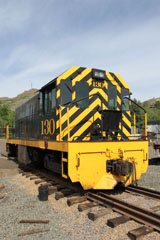
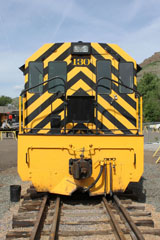
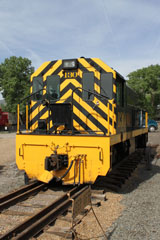

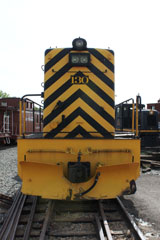
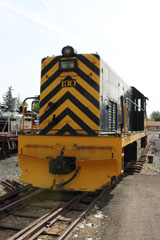
Above, GBL #130 is another
52-Ton narrow gauge road-style GE switcher. Like GBL #140 shown earlier on this page, it worked for US Gypsum where it was #1303 and was sold to the Georgetown Loop in 1992.
Both units appear to have been something of a hybrid. They were produced early in the "Universal" series production run, during which GE continued to refine the design, while Caterpillar and Cummins did the same with the hp rating of their engines.
Because of the changing specifications, there is some confusion about the exact nature of the units, which have been variously described as 50-Ton,
52-Ton, U4B and U6B.
A Yahoo Groups string suggests the best description would be that they might be a "U5.9B", the only difference compared to GE's originally proposed U6B being the absence of a turbocharger. They may also have been the first "Universal" series end-cab units built.

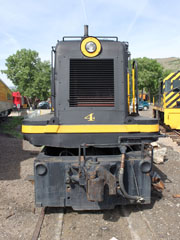
This GE 55-Ton centre cab switcher was formerly on the East Broad Top Railroad in Orbisonia, PA, then at the Durango & Silverton before coming to the museum in 2006.
Like EBT #M-7, which you can see on the East Broad Top page of this website, #4 was built as a 50 ton switcher in 1964, but a subsequent owner increased its weight to 55 tons.
You can see other GE switchers on the North Carolina Transportation Museum page of this website, the Savannah Roundhouse Railroad Museum, the Mid-Continent Railway Museum, the Illinois Railway Museum Yard and the Southeastern Railway Museum pages.
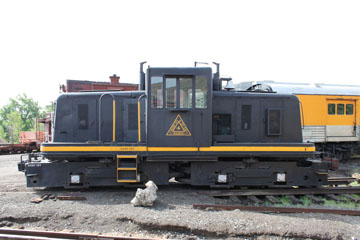
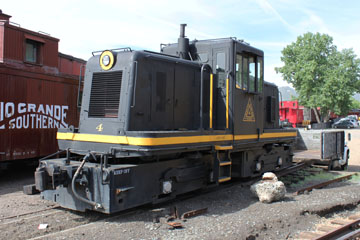
General Electric built a total of one thousand, two hundred and ninety-nine switchers between 1931 and 1981 ranging in size from 20 tons to 132 tons.
Many of the smaller units were built with this centre cab configuration for easy bi-directional operation.
The 50 ton model was produced between 1941 and 1976.


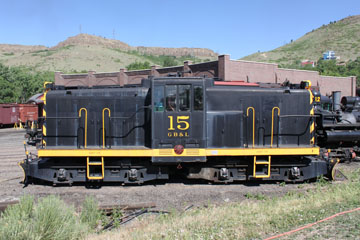
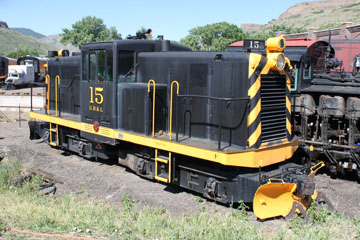

#15 was later sold to the Camino Cable & Northern, a tourist railroad based in Camino, CA. It then went to the Georgetown Loop and, finally, was moved to the Colorado Railroad Museum.
GE built fifty-eight of these narrow gauge switchers between 1943 and 1954, almost wholly for railroads in South America.

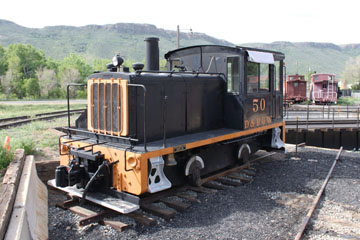
#50 was then purchased by a museum in Durango in 1981 and finally sold to the Colorado Railroad Museum in 1984.
The Davenport Locomotive Works in Davenport,
IA, built locomotives from 1902, starting with
small steam locomotives but going on to produce the first gasoline-fuelled locomotive in 1924 and
the first diesel locomotive in 1927. It then
produced an extensive range of diesel
locomotives in all industrial types and sizes from 4 ton to 112 ton, including H K Porter designs under licence.
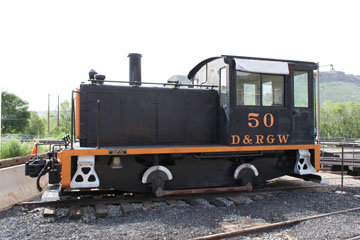
The Davenport Works finally ceased production in 1956.

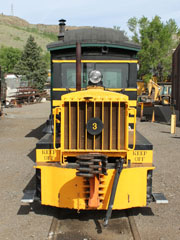
The gasoline powered engine apparently worked for US Gypsum all its life until bought by the Colorado Railroad Museum in 1965.
The "Golden City & San Juan Railroad" herald is another name for the Georgetown Loop. Paradoxically, the engine has a Baldwin #3 front end number plate!
Over 7,500 locomotives were built in Plymouth starting in 1910 under the J. D. Fate Company, then in 1919 as Fate-Root-Heath and only becoming Plymouth Locomotive Works in the late 1950s. They were generally under 25 tons in weight and gasoline burners designed for industrial use. The last engine came off the factory line in 1999.

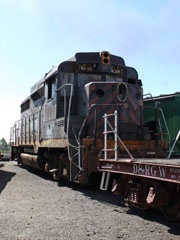
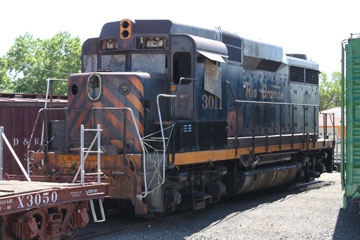
Nine hundred and eight GP30s were built by EMD between 1961 and 1963, all for US railroads. Forty cabless B units were also built for the Union Pacific, and two additional cab units were built by General Motors Diesel (GMD) in London, Ontario for the Canadian Pacific.
The GP30 updated elements of the GP20 but managed to get an extra 250 hp out of the 567 series engine. Powered by a V16 EMD 567D3, the GP30 could deliver 63,375 lbs tractive effort and had a top speed of 65 mph. At 56' 2" in length, it weighs 253,000 lbs.
#3011 is one of twenty-eight GP30s bought by the D&RGW from 1962 to 1963 (#1301-#1328).
It worked from 1962 until 1994. Then bought by Omnitrax, the unit was donated to the museum in February 2003. It was at the Coors brewery until August 2004, when it and Coors #C998, shown earlier on this page, were moved to the museum by truck.

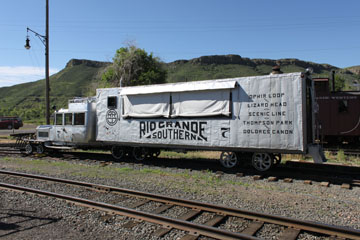
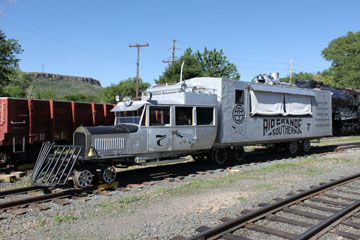
#7 is the last of seven Galloping Goose railcars built in the 1930s by the Rio Grande Southern Railroad. All the "geese" were built at the railroad's shops in Ridgway, CO. #7 was outshopped in October 1936 using a Pierce-Arrow 1926 body and a Ford 1936 V-8 engine.
The first vehicle of this type was built by the RGS in 1913, as a track maintenance crew vehicle. Although it was wrecked in 1925, it inspired the idea of using them for scheduled service. The railroad developed the first of the "geese" to keep its contract to run mail to towns in the Rocky Mountains in Colorado. At the time, there were not enough passengers or cargo to justify the more expensive steam train service.

#6 was built in January 1934 from parts
salvaged from recently scrapped #1, using a Buick body, Buick-6 engine and a non-articulated frame.
Weighing 8,700 lbs and 25' 8" long, the "motor" has two trucks. The rear truck is powered on both its axles.
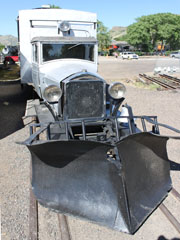
"Motors" were less expensive to operate than steam locomotives and were also much lighter, reducing impact on rails and roadbeds.
The cost savings meant the first Goose, built in 1931, paid for itself and started making a profit within three weeks of going into service. #1 hauled mail, passengers and freight until scrapped in 1933.

Initially painted black and dark green, in 1935, "geese" #2-#6 were all painted silver, as was #7, built the following year. At that time, #2 was kept in Ridgway and used for spares for the other "geese".
In 1950, the RGS lost its mail contract in favour of highway mail carriers, and #3, #4, #5 and #7 were converted for tourist operations. Large windows were cut in the sides of the freight compartments and seating was added. A figure of a running goose and the words "Galloping Goose" were added to the carbody doors and also advertised on signs along the highway. This is the first time the railroad used the name. In Summer 1950, 1,000 people rode the "geese" and, in 1951, 2,000, but that was their last year of passenger service. The RGS had petitioned to discontinue service on the line, and the last work of the "geese" on their home territory was to help take up the rails.
It's not clear where the name "Galloping Goose"
came from. It may have referred to the way the carbody and freight compartment rocked back and forth on the RGS's somewhat rough track. However, it could also have arisen because the "geese" had air horns rather than whistles like RGS's steam locomotives.
This is the oldest surviving Galloping Goose, although you can see a 2003 replica of #1 on the Ridgway Railroad Museum page of this website.
#2 was built in August 1931 from a Buick "Master
Six" four-door sedan with a 28 hp engine. It had a larger frame than #1 and a 16' mail/express compartment, although it still rode on two trucks. Weighing 10,300 lbs and 29' 11" long, the front sat four passengers, and more could ride in the rear or even, apparently, on top. In 1939, #2 was rebuilt with a Pierce-Arrow body and new engine, using parts from a goose that operated on the San Cristobal Railroad from 1935. The cab replaced the one on #2's older Buick body and the motor may have been replaced as well.

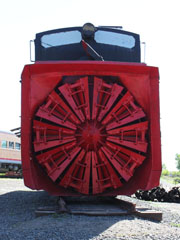
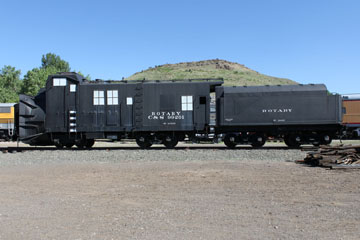
The Cooke Locomotive & Machine Works opened
in 1852 as Danforth-Cooke in Paterson, NJ. It built steam locomotives as well as snow plows until it merged with
seven other manufacturers to form the American
Locomotive Company (Alco) in 1901. Alco continued building locomotives and snow plows at the plant until it was closed in 1926.
There are Cooke/Alco snow plows on the Steamtown page of this website, the Lake Superior Railroad Museum page, the Northwestern Railway Museum, Northern Nevada Railroad
Museum and Mid-Continent Railway Museum pages.
#3 was later renumbered CS #0270 and then #99201. It was converted from 36" gauge to standard gauge soon after delivery, back to 36" in 1935 and then returned to standard gauge in 1943. It was rebuilt in 1949.
The rotary mechanism at the front was operated by a self-contained steam engine inside the car, but the plow could not move under its own power. It had to be pushed by three or four locomotives. Snow was sucked inside the rotary blades and shot to the side of the track from a chute behind the headlight.
The engine weighs 167,220 lbs. The tender weighs 56,620 lbs light.
Top, the cylinders, crosshead and gears. Below, the backhead.


